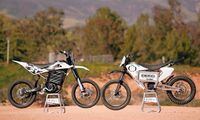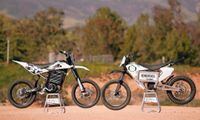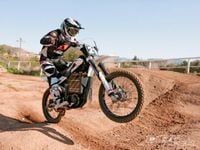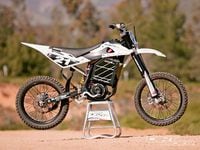The concept of electric motorcycles was once regarded as futuristic and absurd, but given the rapidly growing rate of technology and the ever-shrinking availability of riding areas, it's time to consider alternative innovations. The race to build the first off-road-capable electric bike has been spearheaded by Quantya and Zero, two forward-thinking companies which aren't scared to get dirty. As both of these machines have recently become available to the public for purchase, we got our hands on the new units for the world's first electric bike shootout. From private pitbike tracks to A-level trails, we ran these machines through the electric gauntlet. Surprisingly, we managed to keep both bikes in one piece and running (we avoided deep water crossings!), and in the end we were left with a distinct list of strengths and weaknesses for each machine. What follows is the nitty-gritty of this shocking new slice of the market...Zero-X
What's Hot
. The relatively low weight makes the Zero-X nimble and maneuverable.
. Kill switch lets you know if it's on or off. This may not sound like a big deal, but with a silent motor it's easy to bust a "George" (aka whiskey throttle).
. The power hit is delayed yet consistent, which means that it's fairly easy to adapt to.
. Great power in a light package equals impressive top speed.
. Strong acceleration is super fun to ride on high-traction motocross tracks and open trails.
. The hand rear brake is good for technical riding and can be used to modulate the power delivery. Plus, the mountain-bike feel is welcome while you adapt to silent performance.
. An easily replaceable power pack means almost enough of a moto fix if you have (and can afford to have) a spare unit charged and ready to go.
. The on-the-fly Slow/Fast and Sport/Soft settings are easy to switch and good for teaching someone how to ride.
. Hurray! Real dirt bike tires!
. The shock has decent performance for such a small unit.
. High-quality battery charges consistently and will stay at a decent power level for over an hour at trail pace. At race pace, we were able to squeeze 30 minutes out of a fully charged battery before it started to taper down.What's Not:
. Replacement battery costs a fierce $2950 (plus shipping).
. Overall, the Zero-X feels fragile by motorcycle standards. Consciously preserving the machine as you ride is necessary.
. Hand brake can be difficult for some riders to adjust to. Pads wear out fairly quickly.
. Power delivery is abrupt and breaks loose far too easily in low-traction situations.
. Plastic and graphics look cheap for such an expensive product.
. Awkward ergonomics: Pegs are high and wide, seat is long, hard and flat, and cockpit feels cramped.
. Small spokes give wheels excessive flex and make the front end push into turns and down hills.
. The mountain bike suspension is too soft to ride hard; fork bottoms out easily and often while the shock is slightly better but still too springy.
. Plastic grips are among the worst we've ever felt.
. Scary up-and-down chatter of the fork appears at anything faster than cruising speed-this suspension was not designed to be ridden hard.
. Excessive chain slap and chassis noise are a reminder of the bike's vulnerability.
. Two-hour recharge time.
. Green light on instrument cluster is blinding at night and compromises ninja stealth mode.
. Motor freewheels when off the power.
. Huge rear sprocket and guide are low and vulnerable off-road.
. When the battery is fully depleted, it will not always go dead consistently. Depending on how hard you're riding, the bike will either slow to a snail's pace or simply go from running pace to completely stopped. We never had a battery go dead the same way twice.
Quantya Track
What's Hot:
. Ergonomics make this feel like a real motorcycle-peg location, bar and seat are all up to par.
. Big fork provides great feel and ample performance for real riding.
. Mellower delivery gets great traction and is thus more usable than the Zero-X.
. Standard-sized spokes make strong wheels.
. Rear brake pedal was familiar to most (though a hand brake is also available).
. Graphics and plastics look stealth and aggressive.
. Feels planted and stable, even at speed.
. Strong brake components and other hardware have stout build.
. Hides its weight well and doesn't feel overly heavy on the track.
. Belt drive to relay sprocket takes drive forces off motor.What's Not:
. Tamer power delivery may be better for technical riding but isn't as fast over open terrain, especially at top speed.
. Inconsistent and erratically delayed power delivery; throttle does not feel as directly connected to power delivery as the Zero-X.
. Rear shock feels sag-less, springy and less progressive compared to the fork.
. No kill switch-be careful with the key on!
. Tires are more dual-sport than dirt.
. Power seems to taper down just a little after about 10 minutes, and then stays there for the duration of charge.
. Battery takes longer to recharge than the Zero-X and simply doesn't hold a charge as long-we saw 45 minutes at a trail pace and 25 minutes of hard riding before a considerable power loss.
. Nonremovable battery leaves no option but plug-and-don't-play while it charges.The Winner
When you get down to it, it's difficult to declare an outright winner between these two machines. The Zero-X boasts an awesome, consistent power delivery that just may overlap the chassis' handling and ergonomic oddities. The bike altogether feels like a motorized bicycle, but many of the Zero-X's shortcomings-suspension, grips, spokes and graphics-can be fixed. On the other hand, the Quantya Track feels like riders-not just engineers-built it, though this shows on the scale. The power may not be as consistent as the Zero-X, but the easier initial hit makes the Quantya easier to ride (particularly in off-road situations), and the ergonomics are solid. Between the two machines, the absolute best electric bike would be a combination of the two, as the Quantya's ergonomics and strength with the Zero-X's battery would be a sweet machine. But if we have to pick a winner, we'd hand it to the Zero-X based on the simple fact that the longer-lasting, removable battery equals more time in the saddle. And since we've been having so much fun on these, we really value saddle time!







/cloudfront-us-east-1.images.arcpublishing.com/octane/H3EMT5NJ5BDZPBBH27SW3ADQH4.jpg)
/cloudfront-us-east-1.images.arcpublishing.com/octane/XTROSHDZFJB5DIJYU2VF2REFIU.jpg)
/cloudfront-us-east-1.images.arcpublishing.com/octane/5A776WXBY5GAPDYFTTUEUZNIJA.jpg)
/cloudfront-us-east-1.images.arcpublishing.com/octane/NCYHFQ2S3BAT7EC7VDN2ONGRTU.jpg)
/cloudfront-us-east-1.images.arcpublishing.com/octane/XQORS527YFFT3MVI326EOEYJUI.jpg)
/cloudfront-us-east-1.images.arcpublishing.com/octane/TVDPP3TGMZHODFXASIFUM2KD34.jpg)
/cloudfront-us-east-1.images.arcpublishing.com/octane/EWDMR3DDTBBQPI7DQVZCLMRFAE.jpg)
/cloudfront-us-east-1.images.arcpublishing.com/octane/4XHHLVOUKFE3PDSWNSV4JJMGOE.jpg)
/cloudfront-us-east-1.images.arcpublishing.com/octane/5RLI3NQKQJA3LKKCQHRXQFTL6Q.jpg)
/cloudfront-us-east-1.images.arcpublishing.com/octane/3QCYJCI2RNBENIRWAKEOEKHFUM.jpg)
/cloudfront-us-east-1.images.arcpublishing.com/octane/UZHF7KAE7BFN7KU734ER7PPP3Q.jpg)
/cloudfront-us-east-1.images.arcpublishing.com/octane/XJFFFMRN6VEZ7CDNAGKWVPC3H4.jpg)
/cloudfront-us-east-1.images.arcpublishing.com/octane/RMC3CHWSHFAUJA2WJ2FVG4NBOA.jpg)
/cloudfront-us-east-1.images.arcpublishing.com/octane/WXEZV4WAYBERFKSRE5M7GQBW7A.jpg)
/cloudfront-us-east-1.images.arcpublishing.com/octane/LO3PZVGICFGJZBNUA2ORUSAUSE.jpg)
/cloudfront-us-east-1.images.arcpublishing.com/octane/UFHLTNOXLVARVLZV32M6ZJZV4Y.jpg)
/cloudfront-us-east-1.images.arcpublishing.com/octane/CTSWNU7SNNCC3LWB2KATYZ5AXY.jpg)
/cloudfront-us-east-1.images.arcpublishing.com/octane/IBNGAQWHJJF4TKSIQT54MTWRYQ.jpg)
/cloudfront-us-east-1.images.arcpublishing.com/octane/EAEWHFARGVGHFH4N4BDOSNBJSU.jpg)
/cloudfront-us-east-1.images.arcpublishing.com/octane/AZ7H35TQSZDKZCVM4S6CHERQEU.jpg)
/cloudfront-us-east-1.images.arcpublishing.com/octane/GYMIU7SMN5CWHP6QLFR6MVKEBU.jpg)
/cloudfront-us-east-1.images.arcpublishing.com/octane/B3CX7C4BFFCKBLDWHPQFACBH2E.jpg)
/cloudfront-us-east-1.images.arcpublishing.com/octane/6EIBG7NN4BH4FKDBCPCTLQL6FU.jpg)
/cloudfront-us-east-1.images.arcpublishing.com/octane/3RBI4ZG5NNBCTEUK7MWMKVZ5BE.jpg)